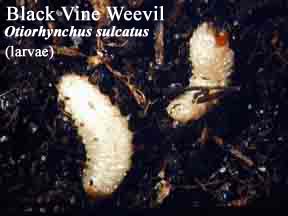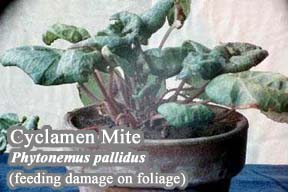Cyclamen (Cyclamen)
Plant
Health Problems
Diseases caused by Fungi:
Botrytis blight, Botrytis cinerea.
Flowers turn a papery brown and become covered with gray,
fuzzy masses. Senescing flowers are particularly susceptible. Tan
to brown spots with a target-like appearance can also develop on
the leaves. These patches are often associated with flowers which
have dropped onto the leaf surface. This disease is particularly
troublesome during periods of extended cloudy, humid, wet
weather.
Good sanitation practices including grooming the plants and
removing spent or senescing flowers can minimize the potential
for infection. These affected tissues should be carefully removed
and discarded when they are dry. It is also important to avoid
wetting the flowers when watering and crowding plants. Adequate
spacing between the plants can promote good air circulation.
Control can also be achieved with the use of fungicide sprays
applied as soon as symptoms are visible. Among the compounds
registered for use in Connecticut are chlorothalonil, copper sulphate
pentahydrate, mancozeb, and thiophanate-methyl. Consult the label for dosage rates and safety
precautions.
Fusarium wilt, Fusarium oxysporum f. sp. cyclaminis.
Symptoms of this disease can develop at any stage of plant
growth. Leaves may appear yellow, wilt, and collapse. Some plants
may show no signs of infection until they come into flower, when
they suddenly collapse. Diagnostic symptoms can occasionally be
seen when the stem is cut to reveal a purple, reddish-brown to
black discoloration of the vascular system in the crown.
Control of this disease is difficult once plants are infected.
Therefore, the key strategy for control of vascular wilts is
prevention. It is important to avoid planting cyclamen in
infested soil. It is also helpful to maximize plant vigor by good
cultural care and watering. Careful handling of plants will avoid
root injury which enables the fungus to enter the plant. Since
repeated use of the same area greatly increases the amount of
disease, rotation is essential. Resistant varieties are not
available at the present time. Chemical controls are not
effective for this fungus.
Diseases caused by Viruses:
Impatiens necrotic spot, virus (INSV).
Symptoms appear as round, brown, necrotic spots on the leaves.
Brown or yellow ringspots can also develop and a browning of the
petiole end of the leaf has occasionally been reported. This
pathogen is transmitted by the western flower thrips.
Control of this disease is focused on prevention since once
plants are infected, they cannot be cured. It is important to
eliminate and remove infected plants as soon as they are
recognized and to eliminate other symptomatic plants in close
proximity since this virus has a very broad host range. It is
also critical to manage the thrips population.
Diseases caused by Nematodes:
Foliar nematodes, Aphelenchoides.
These plant-parasitic worms attack virtually all plant parts and
may cause leaf lesions, yellowing, necrosis, and leaf drop.
Leaves and stems can collapse or the plant may not produce normal
buds. Lower leaves first show brown wedge-shaped areas between
the veins which eventually involve the entire leaf. Discoloration
then progresses from the bottom to the top of the plant. The
nematodes live and move in water films.
Reducing leaf moisture by avoiding overhead irrigation and
removal of infected tissues, debris, or plants are important for
control.
Insect Problems:
 Black vine weevil,
Otiorhynchus sulcatus.
Black vine weevil,
Otiorhynchus sulcatus.
The grubs devour the small roots, or burrow within the cyclamen
corm. The tops of injured plants wilt and often die. Leaf
notching by adults can also be unsightly. The 1/2" long
adult weevil is black, with a beaded appearance to the thorax and
scattered spots of yellow hairs on the wing covers. Only females
are known, and the adults are flightless. They feed nocturnally,
notching the margins of the foliage. The legless grub is white
with a brown head and is curved like grubs of other weevils.
Adults and large larvae overwinter, emerging from May - July. The
adults have to feed for 3-4 weeks before being able to lay eggs.
Treating the soil with insect pathogenic nematodes may control
the larvae and is a sensible approach for house plants and
landscapes.
 Cyclamen mite, Phytonemus pallidus.
Cyclamen mite, Phytonemus pallidus.
This translucent, microscopic mite often infests the new leaf and
blossom buds, and can proliferate on spent blossoms.
Characteristic injury includes dwarfed, thickened and wrinkled
leaves. On azalea, dahlia, and other plants with stems, the
distance between internodes becomes drastically shortened.
Infested plants do not bloom, or blossoms may be misshapen.
Cyclamen mite is not easily controlled when mature plants are
badly infested: effective miticides are not available to
homeowners, so a commercial applicator may be required for
effective miticide applications. Effective restricted use
products include abamectin, dicofol, and endosulfan. Consult the
label and follow all safety precautions. Hot water treatment at
120F for 15 minutes controls cyclamen mite on corms.

